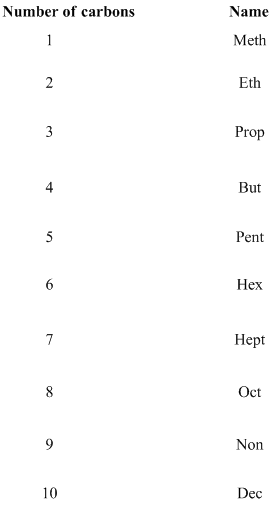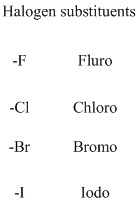
Interpretation:
The structural isomer, chirality and systematic name should be identified for the given formula of
Concept introduction:
Isomer: Molecule has same molecular formula but different structural arrangement is called isomer.
Chiral: Absence of a plane of symmetry or a center of symmetry is called chiral molecule, a non-superimposable on its mirror image is called chiral. A carbon atom is attached by the four different groups is called chiral carbon.
Achiral: Presence of a plane of symmetry or a center of symmetry is called achiral molecule, a superimposable on its mirror image is called achiral. A carbon atom does not have four different groups is called achiral carbon
Geometric isomerism (also known as E-Z isomerism or cis-trans isomerism): same molecular formula but different arrangement in the space. These isomers happen where you have restricted rotation in a molecule (double bond in the molecule). The
Organic compounds are named systematically by using IUPAC rules.
Name of the organic compounds are given according to the number of carbon present in the molecule for example
A molecule having one carbon atom, the molecule name will start with meth etc.…

If any halogens are present in the molecule, the name of the halogens as follows.

Naming the substituted
- (1) Name the parent alkane (long alkyl chain)
- (2) Number the carbon
- (3) Name and number the substituent
If the molecules have the multiple substituents, the compound named as di, tri, tetra, penta, ect.

If the molecules having functional group, the name of the compound is given below. Numbering should be starts from the functional group of the given molecule.
The given compound is an alcohol
Example is given below


Want to see the full answer?
Check out a sample textbook solution
Chapter 23 Solutions
Chemistry: Atoms First V1
- What alkyne (or diyne) yields the following oxidative cleavage products? Click the "draw structure" button to launch the drawing utility. draw structure ... CO₂ + OHarrow_forwardlighting discharges in the atmosphere catalyze the conversion of nitrogen to nitric oxide. How many grams of nitrogen would be required to make 25.0 g of nitric oxide in this way ?arrow_forwardThe electron of a hydrogen atom is excited to the 4d orbital. Calculate the energy of the emitted photon if the electron were to move to each of the following orbitals: (a) 1s; (b) 2p; (c) 2s; (d) 4s. (e) Suppose the outermost electron of a potassium atom were excited to a 4d orbital and then moved to each of these same orbitals. Describe qualitatively the differences that would be found between the emission spectra of potassium and hydrogen (do not perform calculations). Explain your answer.arrow_forward
- Imagine a four-dimensional world. In it, atoms would have one s orbital and four p orbitals in a given shell. (a) Describe the shape of the Periodic Table of the first 24 elements. (b) What elements would be the first two noble gases (use the names from our world that correspond to the atomic numbers).arrow_forwardThe electron affinity of thulium was measured by a technique called laser photodetachment electron spectroscopy. In this technique, a gaseous beam of anions of an element is bombarded with photons from a laser. The photons knock electrons off some of the anions, and the energies of the emitted electrons are detected. The incident radiation had a wavelength of 1064 nm, and the emitted electrons had an energy of 0.137 eV. Although the analysis is more complicated, we can obtain an estimate of the electron affinity from the energy difference between the photons and the emitted electrons. What is the electron affinity of thulium in electron volts and in kilojoules per mole?arrow_forwardBe sure to answer all parts. The following alkyne is treated with 03 followed by H₂O. Part 1: How many different compounds are formed in this process? 1 Part 2 out of 2 Draw the product of the reaction. draw structure ...arrow_forward
- Many fireworks use magnesium to burn, which releases a significant amount of energy. The heat released causes the oxide to glow, emitting white light. The color of this light can be changed by including nitrates and chlorides of elements that emit in the visible region of their spectra. One such compound is barium nitrate, which produces a yellow-green light. Excited barium ions generate light with wavelengths of 487 nm, 524 nm, 543 nm, and 578 nm. For each case, calculate: (a) the change in energy (in electron volts) of a barium atom and (b) the molar change in energy (in kilojoules per second).arrow_forwardClouds of hot, luminous interstellar hydrogen gas can be seen in some parts of the galaxy. In some hydrogen atoms, electrons are excited to quantum levels with n = 100 or higher. (a) Calculate the wavelength observed on Earth if the electrons fall from the level with n = 100 to one with n = 2. (b) In what series would this transition be found? (c) Some of these high-energy electrons fall into intermediate states, such as n = 90. Would the wavelengths of a transition from the state with n = 100 to one with n = 90 be longer or shorter than those in the Balmer series? Explain your answer.arrow_forwardIn the spectroscopic technique known as photoelectron spectroscopy (PES), ultraviolet radiation is directed at an atom or molecule. Electrons are ejected from the valence shell and their kinetic energies are measured. Since the energy of the incident ultraviolet photons is known and the kinetic energy of the ejected electron is measured, the ionization energy, I, can be deduced because total energy is conserved. (a) Show that the velocity, v, of the ejected electron and the frequency, n, of the incident radiation are related by hv = I + (1/2)mv^2? (b) Use this relation to calculate the ionization energy of a rubidium atom, knowing that light of wavelength 58.4 nm produces electrons with a velocity of 2,450 km/s Recall that 1 J = 1 kg.m^2/s^2arrow_forward
- I) In Millikan's experiment, each droplet observed by the technicians contained an even number of electrons. If they had been unaware of this limitation, how would it have affected their report of an electron's charge?II) Millikan measured the charge of an electron in electrostatic units, esu. The data he collected included the following series of charges found on oil drops: 9.60 X 10^-10 esu, 1.92 X 10^-9 esu; 2.40 X 10^-9 esu; 2.88 X 10^-9 esu; and 4.80 X 10^-9 esu. (a) From this series, find the probable charge of the electron in electrostatic units. (b) Estimate the number of electrons in an oil drop with a charge of 6.72 X 10^-9 esu. The actual charge (in Coulombs) of an electron is 1.602 X 10^-19 C. What is the relationship between esu and Coulombs?arrow_forwardmy ccc edu - Search X Quick Access X D2L Homepage - Spring 2025 x N Netflix X Dimensional Analysis - A x+ pp.aktiv.com Q ☆ X Question 59 of 70 The volume of 1 unit of plasma is 200.0 mL If the recommended dosage for adult patients is 10.0 mL per kg of body mass, how many units are needed for a patient with a body mass of 80.0 kg ? 80.0 kg 10.0 DAL 1 units X X 4.00 units 1 1 Jeg 200.0 DAL L 1 units X 200.0 mL = 4.00 units ADD FACTOR *( ) DELETE ANSWER RESET D 200.0 2.00 1.60 × 10³ 80.0 4.00 0.0400 0.250 10.0 8.00 & mL mL/kg kg units/mL L unit Q Search delete prt sc 111 110 19arrow_forwardIdentify the starting material in the following reaction. Click the "draw structure" button to launch the drawing utility. draw structure ... [1] 0 3 C10H18 [2] CH3SCH3 Harrow_forward
 ChemistryChemistryISBN:9781305957404Author:Steven S. Zumdahl, Susan A. Zumdahl, Donald J. DeCostePublisher:Cengage LearningChemistry: Matter and ChangeChemistryISBN:9780078746376Author:Dinah Zike, Laurel Dingrando, Nicholas Hainen, Cheryl WistromPublisher:Glencoe/McGraw-Hill School Pub Co
ChemistryChemistryISBN:9781305957404Author:Steven S. Zumdahl, Susan A. Zumdahl, Donald J. DeCostePublisher:Cengage LearningChemistry: Matter and ChangeChemistryISBN:9780078746376Author:Dinah Zike, Laurel Dingrando, Nicholas Hainen, Cheryl WistromPublisher:Glencoe/McGraw-Hill School Pub Co Chemistry: Principles and PracticeChemistryISBN:9780534420123Author:Daniel L. Reger, Scott R. Goode, David W. Ball, Edward MercerPublisher:Cengage Learning
Chemistry: Principles and PracticeChemistryISBN:9780534420123Author:Daniel L. Reger, Scott R. Goode, David W. Ball, Edward MercerPublisher:Cengage Learning Chemistry: Principles and ReactionsChemistryISBN:9781305079373Author:William L. Masterton, Cecile N. HurleyPublisher:Cengage Learning
Chemistry: Principles and ReactionsChemistryISBN:9781305079373Author:William L. Masterton, Cecile N. HurleyPublisher:Cengage Learning Chemistry: The Molecular ScienceChemistryISBN:9781285199047Author:John W. Moore, Conrad L. StanitskiPublisher:Cengage Learning
Chemistry: The Molecular ScienceChemistryISBN:9781285199047Author:John W. Moore, Conrad L. StanitskiPublisher:Cengage Learning Chemistry & Chemical ReactivityChemistryISBN:9781337399074Author:John C. Kotz, Paul M. Treichel, John Townsend, David TreichelPublisher:Cengage Learning
Chemistry & Chemical ReactivityChemistryISBN:9781337399074Author:John C. Kotz, Paul M. Treichel, John Townsend, David TreichelPublisher:Cengage Learning





